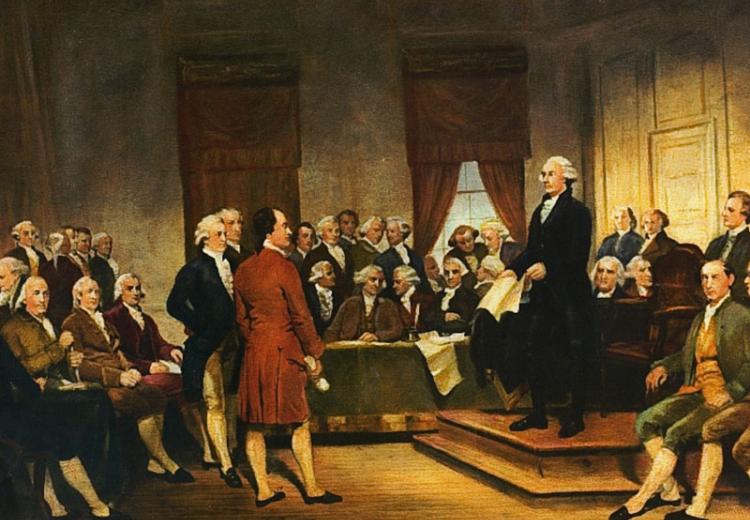The Constitutional Convention of 1787

Washington at Constitutional Convention of 1787, signing of U.S. Constitution.
On the last day of the Constitutional Convention in Philadelphia, Benjamin Franklin observed that he had often wondered whether the design on the president's chair depicted a rising or a setting sun. "Now at length," he remarked, "I have the happiness to know that it is a rising and not a setting sun."
Franklin's optimism came only after many months of debate and argumentation over the form of government that would best secure the future safety and happiness of the young American republic. At times it seemed that the Convention would fail as a result of seemingly irreconcilable views between the delegates, especially on the questions of selecting representatives to Congress, the relationship of the national and state governments, and the powers of the president. After a month of deadlock over the issue of representation, Franklin himself had called for a prayer because "mankind may hereafter from this unfortunate instance, despair of establishing Governments by Human wisdom."
In this unit, students will examine the roles that key American founders played in creating the Constitution, and the challenges they faced in the process. They will learn why many Americans in the 1780s believed that reforms to the Articles of Confederation were necessary, and the steps taken to authorize the 1787 Convention in Philadelphia. They will become familiar with the main issues that divided delegates at the Convention, particularly the questions of representation in Congress and the office of the presidency. Finally, they will see how a spirit of compromise, in the end, was necessary for the Convention to fulfill its task of improving the American political system.
Guiding Questions
Was the Philadelphia Convention of 1787 necessary to preserve the Union?
Why was the question of representation such an important issue to the delegates at the Constitutional Convention of 1787?
Why was creating the office of the presidency such an important and difficult task for the delegates at the Constitutional Convention of 1787?
Learning Objectives
Analyze the steps taken by Americans to bring about the 1787 Convention by placing key events in historical order in a timeline.
Examine actions taken by several state governments that violated the Articles of Confederation and acts of Congress.
Examine the powers of Congress under the Articles of Confederation and evaluate the extent to which those powers ensured the prosperity and security of the United States.
Compare the views of several American founders about the problems of the American political system in the 1780s.
Evaluate the schemes of representation in the Virginia Plan, the New Jersey Plan, and the Hamilton Plan.
Evaluate the extent to which the Connecticut Compromise resolved the question of representation.
Analyze the competing perspectives around the creation of a Chief Executive and evaluate how the office of the President was codified in the U.S. Constitution.
Compare the responsibilities of a President identified in the U.S. Constitution with the powers and responsibilities today.
